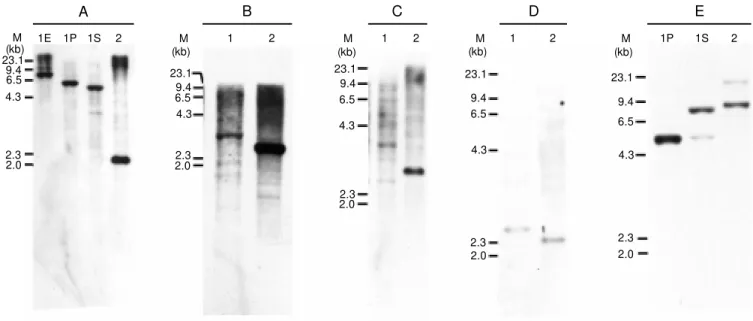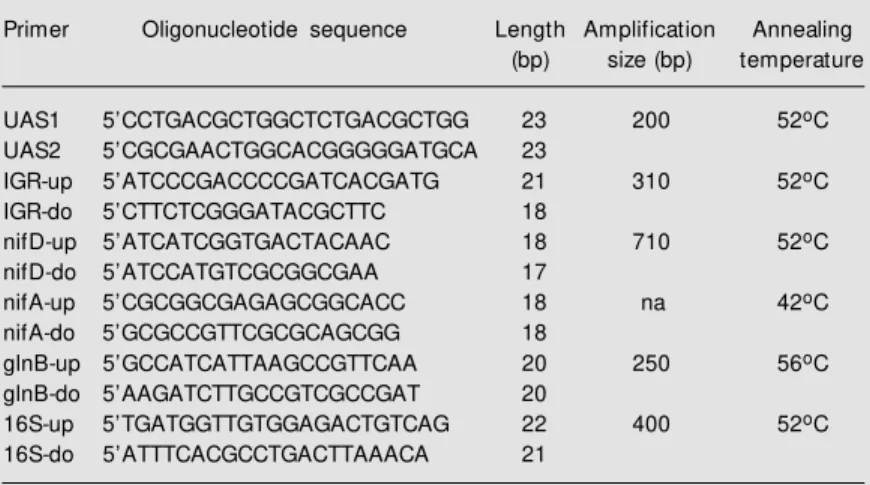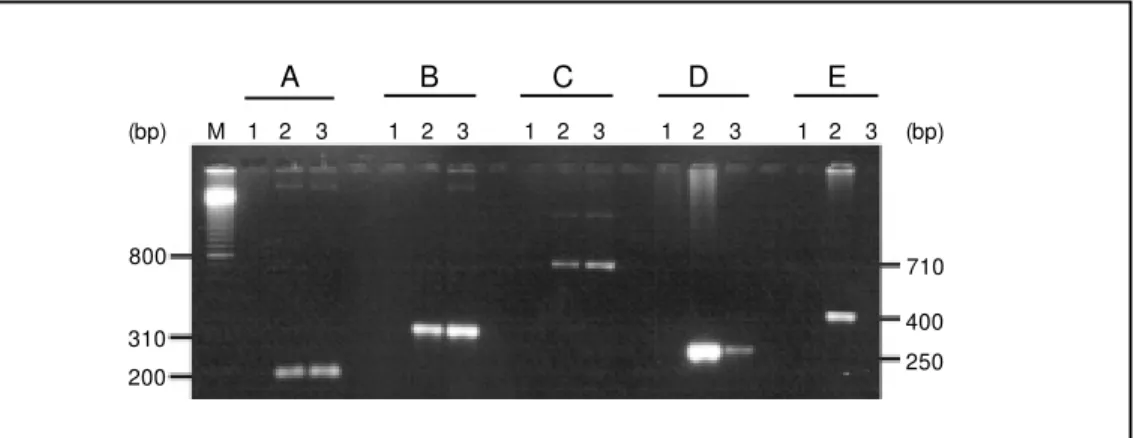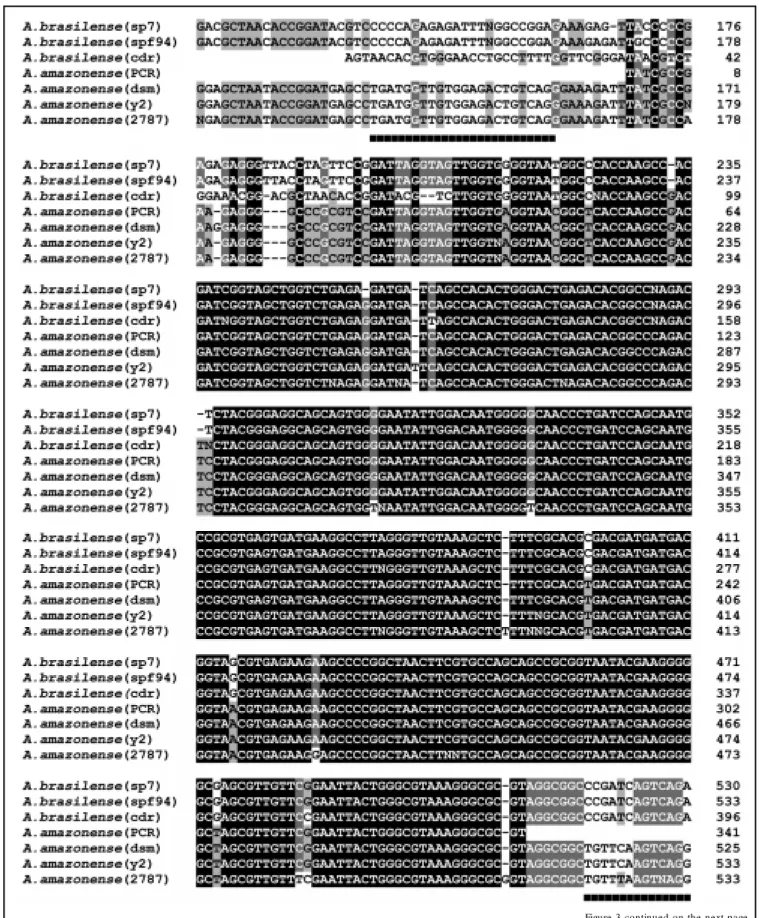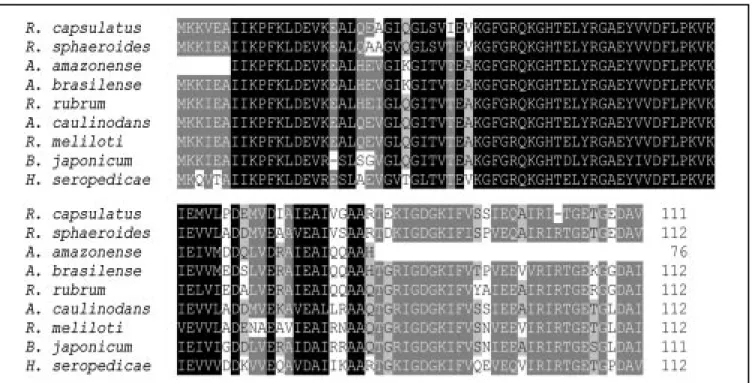Partial characte rizatio n o f
nif
ge ne s
fro m the bacte rium
Az osp irillum
am az onense
1Centro de Biotecnologia, and Departamentos de 2Biologia Molecular e Biotecnologia and 3Genética,
Universidade Federal do Rio Grande do Sul, Porto Alegre, RS, Brasil D.P. Potrich1,
L.M.P. Passaglia1,3
and I.S. Schrank1,2
Abstract
Azospirillum amazonense revealed genomic organization patterns of the nitrogen fixation genes similar to those of the distantly related species A. brasilense. Our work suggests that A. brasilensenifHDK, nifENX, fixABC operons and nifA and glnB genes may be structurally homologous to the counterpart genes of A. amazonense. This is the first analysis revealing homology between A. brasilense nif genes and the A. amazonense genome. Sequence analysis of PCR amplification products revealed similarities between the amino acid sequences of the highly conserved nifD and glnB genes of A. amazonense and related genes of A. brasilense and other bacteria. However, the A. amazonense non-coding regions (the upstream activator sequence region and the region between the nifH and nifD genes) differed from related regions of A. brasilense even in nitrogenase structural genes which are highly conserved among diazotrophic bacteria. The feasibil-ity of the 16S ribosomal RNA gene-based PCR system for specific detection of A. amazonense was shown. Our results indicate that the PCR primers for 16S rDNA defined in this article are highly specific to A. amazonense and can distinguish this species from A. brasilense. Co rre spo nde nce
I.S. Schrank
Centro de Biotecnologia
Departamento de Biologia Molecular e Biotecnologia
Av. Bento Gonçalves, 9500 Caixa Postal 15005 91591-970 Porto Alegre, RS Brasil
Research supported by FAPERGS and CNPq. D.P. Potrich is the recipient of a CAPES fellowship.
Received O ctober 26, 2000 Accepted June 18, 2001
Ke y words
·Azospirillum am azonense
·nif genes ·glnB
·16S rDNA
Intro ductio n
Bacteria belonging to the genus Azospi-rillum are found associated with forage grasses, cereals and agriculturally important crops from various geographical origins. This genus consists of seven species, A. lipoferum, A. brasilense, A. amazonense, A. haloprae-ferens, A. irakense (1), A. largomobile (2), and A. doebereinerae (Eckert B, Baller-Weber O, Kirchhof G, Halbritter A, Stoffels M and Hartmann A, unpublished results, and GenBank accession number AJ238576). Worldwide inoculation experiments using a variety of crops have shown that
Azospiril-lum species can contribute to the nitrogen economy (3,4). In addition, experiments with sugarcane and other crops suggest either a synergistic or an additive effect when A. amazonense is used in combination with other diazotrophics as inoculant (5).
rDNA restriction fragment length polymor-phism (7). The phylogenetic analysis, based on 16S rDNA sequences, confirmed that A. amazonense and A. irakense form one clus-ter and that the closely related species A. brasilense and A. lipoferum form a second cluster together with A. halopraeferens (8). During the last few years, nitrogen fixa-tion (nif) genes have been isolated from a variety of diazotrophic organisms. In A. brasilense a DNA fragment of 25,100 bp encompassing the nif region was shown to contain the nifHDKORF1Y (9), the ORF2nifUSVORF4 (10), an mcp-like gene, the nifENXORF3,5,fdxAnifQ, and the fixABCX (Gross J, Vedoy C and Schrank IS, unpublished results) transcriptional units. However, to date, few genes were isolated from A. amazonense and none of them could be related to the biological nitrogen fixation process.
We report here the application of PCR and Southern hybridization to characterize some of the nif genes from A. amazonense. We have also analyzed the amplification products from two conserved regions within the nifD and glnB genes. Moreover, we have developed primers that specifically amplify A. amazonense DNA and allow us to distin-guish between this species and A. brasilense.
Mate rial and Me thods
Bacte rial strains and growth conditions
A. brasilense Sp7 (ATCC29145) and A. amazonense (ATCC35119) were grown on NFB and LGI minimal media, respectively, as previously described (6,11).
DNA manipulation and se que nce analysis
All DNA manipulations were performed using standard techniques (12) and instruc-tions provided by suppliers of material, en-zymes or reagents. Total DNA extraction of A. amazonense was performed as previously described (13) and Southern blot analysis was performed with the ECL Direct Nucleic Acid Labeling and Detection Systems (Amer-sham Pharmacia Biotech, Uppsala, Sweden).
The nucleotide sequence determination was performed by the chain-termination method of Sanger et al. (14) using 33P-dNTPs and the ThermoSequenase radiolabeled terminator cycle sequencing kit (Amersham). The PCR products were purified using the GFX PCR kit from Amersham. Analysis of DNA se-quences and comparison with nucleotide and deduced protein sequences from other or-ganisms were performed using the GCG (Wisconsin Package Version 9.0, Genetics Computer Group, Madison, WI, USA) com-puter programs (licensed to CENARGEN-EMBRAPA, Brasília, DF, Brazil).
Amplification conditions
PCR amplification of the target sequences was performed using a DNA thermal cycler (MJ Research, Waltham, MA, USA). The PCR mixture contained the reaction buffer (50 mM KCl, 10 mM Tris-HCl, pH 8.3, 2.5 mM MgCl2), 200 µM of each dNTP, 30 pmol of each primer, 1 U of Taq polymerase (CenBiot enzymes, Centro de Biotecnologia, UFRGS, Porto Alegre, RS, Brazil), template DNA, and distilled water to a final concen-tration of 25 µl. The reaction mixture was subjected to PCR under the following condi-tions: heat denaturation at 94oC for 5 min and then an additional 35 cycles with heat denaturation at 94oC for 30 s, annealing (at a temperature defined for each set of primers, see Table 2) for 30 s, and DNA extension at 72oC for 30 s. After the last cycle, samples were maintained at annealing temperature for 5 min followed by 72oC for 10 min. PCR products were analyzed by gel electrophore-sis (12). Primers listed in Table 2 were pur-chased from Oligo ETC. & Oligo Therapeu-tics Inc. (Wilsonville, OR, USA).
Re sults and D iscussion
A. amaz onense nif ge ne s: hybridization and PCR
Figure 1. Hybridization pattern of Azospirillum amazonense total DNA w ith EcoRI (1E), PstI (1P), and SalI (1S) in A, SalI in B, C and D, and PstI (1P) and SalI (1S) in E w ith the follow ing probes: nifD in panel A; nifEN in panel B; fixABC in panel C; nifA in panel D, and glnB in panel E. Lane 2 represents A. brasilense total DNA digested w ith PstI in A, C and E, or SalI in B and D. Lane M contains l HindIII as molecular marker.
23.1 9.4 6.5 4.3
2.3 2.0
6.5 23.1 9.4
4.3
2.3 2.0
6.5 23.1 9.4
4.3
2.3 2.0
6.5 23.1
9.4
4.3
2.3 2.0
6.5 23.1
9.4
4.3
2.3 2.0
M 1E 1P 1S 2
A B C D E
M 1 2 M 1 2 M 1 2 M 1P 1S 2
brasilense, we used two different approaches. Initially, DNA fragments from different nif operons already characterized in A. brasilense were used in Southern blot hybridization to analyze the relatedness between the two Azospirillum species. The hybridization pat-terns of A. amazonense DNA are shown in Figure 1. The nif structural genes from A. amazonense are localized in a 6.5-kb EcoRI DNA fragment (Figure 1A) as previously found for A. brasilense genome (13). In A. brasilense and other diazotrophic bacteria the nifHDK genes are organized in a single transcriptional unit (9). To determine whether the A. amazonensenif genes are clustered in a similar manner as found in A. brasilense and other nitrogen-fixing organisms, we used sequences from nif genes (Table 1) from A. brasilense as DNA hybridization probes. Three different probes, which consist of the entire nifHDK operon (data not shown), the nifH gene alone (data not shown) from A. brasilense, and a region of the nifD gene (Table 1) from A. amazonense, showed ho-mology with the same DNA fragment from A. amazonense (Figure 1A, lane 1E). This result suggests that the region comprising a 6.5-kb EcoRI DNA fragment probably con-tains the nifHD homologous in A.
amazon-ense and that the genes are organized in a single operon. Nevertheless, the hybridiza-tion pattern of the nifD gene amplified from A. amazonense revealed a different restric-tion pattern when A. amazonense and A. brasilense total DNA was digested with PstI and SalI restriction enzymes (Figure 1A, lanes 1P and 1S). A hybridization signal specific to SalI DNA fragments was ob-tained when A. amazonense total DNA was hybridized with A. brasilense nifENX and fixABC probes, respectively (Figure 1B, lane 1 and Figure 1C, lane 1).
In order to understand the nature of the A. amazonense genes that regulate nitrogen fixa-tion we have isolated and characterized the nifA and glnB genes, which are responsible for the regulation of other nif genes and operons in A. brasilense (15,16). The pres-ence of genes homologous to glnB and nifA was detected by hybridization of A. amazon-ense DNA with two different probes (Table 1). The entire nifA gene from A. brasilense is present within a 2.5-kb SalI DNA fragment (15). Heterologous hybridization revealed that the nifA homologue in A. amazonense is also found in a SalI DNA fragment of ap-proximately 3 kb (Figure 1D, lane 1).
The glnB homologous gene was
ized within a 4.5-kb PstI DNA fragment from A. amazonense (Figure 1E, lane 1P). Faint hybridization signals were detected in A. amazonense total DNA and also with PstI-digested A. brasilense total DNA (Fig-ure 1E, lane 2). Genes homologous to glnB have been found in A. brasilense, Herbaspi-rillum seropedicae and other bacteria, sug-gesting the presence of two copies of glnB -like genes in these organisms (17,18). Since no PstI restriction site was found within glnB or glnZ genes from A. brasilense or in
the glnB gene from A. amazonense, the pres-ence of two hybridization fragments in both strains may represent similarity between the probe and the two glnB-like genes.
The results presented here are the first to reveal homology between A. brasilense nif genes and A. amazonense total DNA. Taken together, these results suggest that the nifHDK, nifENX and fixABC operons and the nifA and glnB genes may be structurally homologous to A. amazonense counterpart genes.
The second approach to the understand-ing of the nature of nitrogen fixation in A. amazonense was based on PCR amplifica-tion of regions within the nif/fix genes. Sev-eral primers were selected from the sequences of the nif/fix genes from A. brasilense. The primers listed in Table 2 represent, except for nifA, those that revealed positive and conclusive results after PCR amplification and DNA sequencing. Three sets of primers were designed from regions within the A. brasilense nifHDK operon. The promoter region of this operon shows two overlapping upstream activator sequences (UAS) as the only potential NifA-binding sites (19). To date this organization seems to be unique to A. brasilense and may be an atypical NifA-binding site interacting with two dimers of NifA, as proposed to occur in other nif pro-moters (20). UAS primers define a region of approximately 200 bp in the nifH promoter sequence encompassing the two overlapping UAS. The second pair of IGR primers is derived from the intergenic region between nifH and nifD and amplifies a 310-bp region. In A. brasilense three inverted repeat struc-tures have been found downstream from the nifH stop codon (9). Transcription analysis revealed the presence of one 1.1-kb tran-script corresponding to the nifH gene (21). The nifD primer pair is specific for a 710-bp region of the nifD gene containing a highly conserved amino acid sequence and a serine residue which is present only in the nifD gene of A. brasilense (9).
Amplification of A. amazonense DNA with the above selected primers (Table 2) resulted in fragments of the predicted size (Figure 2A,B,C). All three amplified DNA
Table 2. Oligonucleotide primers.
Primer Oligonucleotide sequence Length Amplification Annealing
(bp) size (bp) temperature
UAS1 5’CCTGACGCTGGCTCTGACGCTGG 23 200 52oC
UAS2 5’CGCGAACTGGCACGGGGGATGCA 23
IGR-up 5’ATCCCGACCCCGATCACGATG 21 310 52oC
IGR-do 5’CTTCTCGGGATACGCTTC 18
nifD-up 5’ATCATCGGTGACTACAAC 18 710 52oC
nifD-do 5’ATCCATGTCGCGGCGAA 17
nifA-up 5’CGCGGCGAGAGCGGCACC 18 na 42oC
nifA-do 5’GCGCCGTTCGCGCAGCGG 18
glnB-up 5’GCCATCATTAAGCCGTTCAA 20 250 56oC
glnB-do 5’AAGATCTTGCCGTCGCCGAT 20
16S-up 5’TGATGGTTGTGGAGACTGTCAG 22 400 52oC
16S-do 5’ATTTCACGCCTGACTTAAACA 21
UAS = upstream activator sequences; IGR = intergenic region; na = no amplification; do = dow nstream; up = upstream.
Table 1. Plasmids and probes.
Probe Characteristics Reference
nifHDK 6.5-kb EcoRI A. brasilense 9
DNA fragment (nifHDKORF1Y operon)
nifH 2.8-kb EcoRI/PstI A. brasilense 9
DNA fragment (nifHDKORF1Y operon)
nifD A. amazonense PCR fragment Present study
glnB/PII A. amazonense PCR fragment Present study
nifA 2.5-kb SalI A. brasilense Pedrosa F (w ith permission)
DNA fragment (nifA gene)
nifEN 2.2-kb EcoRI/HindIII A. brasilense Potrich D, Bressel T,
DNA fragment (nifENX operon) Schrank IS and Passaglia L
(unpublished results)
fixABC 3.0-kb PstI A. brasilense Gross J, Vedoy C and
fragments were used to probe total A. ama-zonense DNA, revealing homology with the same EcoRI fragment encompassing the nifHD genes (Figure 1A). To further charac-terize the PCR products, all DNA fragments were purified and sequenced. The sequences for the UAS and IGR products showed very little similarity to the A. brasilense counter-parts (data not shown). Only the region am-plified within the nifD gene is similar to other nifD gene sequences (discussed be-low). These results indicate that the A. ama-zonense non-coding regions described above differ from related A. brasilense regions even among nitrogenase structural genes which are highly conserved among diazotrophic bacteria.
A set of primers was designed (Table 2) from previously published sequences of nifA and glnB genes from A. brasilense (15,22). A PCR product of approximately 250 bp was detected in A. amazonense DNA (Figure 2D, lane 1). This product hybridized with total A. amazonense DNA (Figure 1E, lanes 1P and 1S) and, after DNA sequencing, revealed ho-mology with PII proteins from different organ-isms (discussed below). Surprisingly, no am-plification product was visualized when nifA target primers were applied to A. amazonense DNA although these primers were designed on the basis of a highly conserved region found among NifA proteins from A. brasi-lense, A. lipoferum and related bacteria. This unexpected result suggests that the A. amazonensenifA gene may have greater dif-ferences in DNA sequence than found among other nifA genes previously characterized.
Amplification of A. amaz onense 16S rDNA
To overcome problems with misinterpre-tation of the PCR results, a PCR amplifica-tion system was developed to specifically detect A. amazonense. The 16S rRNA se-quence from Azospirillum species was ob-tained from the GenBank database. Multiple sequence alignments to other 16S rRNA gene sequences revealed one region of consider-able sequence divergence from the closest relatives, as shown in Figure 3. Two primers (16S-up and 16S-do) were constructed, one based on the variable region and the other based on a lower sequence divergence re-gion (Table 2). The PCR product generated with A. amazonense was 400 bp long (Figure 2E, lane 2) and was confirmed by direct sequencing (Figure 3). No PCR product was detected when A. brasilense DNA was the template (Figure 2E, lane 3). Using this meth-odology we could specifically detect and differentiate DNA templates from these two Azospirillum species.
Inte rspe cie s conse rvation of nif/gln ge ne s
A sequence comparison of the A. ama-zonense and A. brasilense nifD genes re-vealed a high degree of similarity at both the DNA and amino acid levels (Figure 4). One relevant difference between A. amazonense and A. brasilense NifD proteins is located at position 275 (relative to A. brasilense NifD sequence; 9). The A. brasilense nifD gene product contains a total of five cysteine resi-dues, four of which are highly conserved
Figure 2. Specific PCR for am-plification of nif genes from Azospirillum amazonense. Am-plified products on 1.5% aga-rose gel w ere visualized w ith a UV transilluminator after ethi-dium bromide staining using the f ollow ing prim ers: panel A,
UAS; panel B, IGR; panel C,
nifD; panel D, glnB, and panel E, rRNA from A. amazonense (lane 2) and A. brasilense (lane 3) to-tal DNA. The negative control (lane 1) contains no template DNA in the reaction mixture. Lane M contains the 100-bp DNA ladder (Gibco/BRL). 800
310
200
710
400
250
M 1 2 3
A
1 2 3 1 2 3 1 2 3 1 2 3
B C D E
Continued
Figure 4. Azospirillum amazonense nifD protein partial sequence alignment w ith A. brasilense (GenBank accession No. M 64344), Herbaspirillum seropedicae (GenBank accession No. Z54207) and A. vinelandii (GenBank accession No. M 20568) NifD proteins. A grey background indicates similarity including the conserved amino acid substitutions w hile using the A. amazonense sequence as reference sequence. Amino acid-derived sequence from DNA sequencing obtained w ith primer nifD-up (A) and w ith primer nifD-do (B). The cysteine residue 275 is marked w ith an asterisk. M ultiple alignments w ere done w ith the PILEUP program, University of Wisconsin Genetics Computer Group, and the alignment editing w as done w ith the GENDOC program considering the Dayhoff PAM 250 score table (26,27).
A
B
Figure 3. M ultiple sequence alignment of the 16S rDNA genes from Azospirillum amazonense (GenBank accession Nos. X79735, Z29616, X79742) and the distantly related A. brasilense Sp7 (GenBank accession Nos. X79732, 79739, 79740). A. amazonense (PCR) represents the PCR DNA sequence obtained in the present study. The primers used here for the PCR amplification experiments are underlined. A black background indicates conserved residues in all aligned sequences, a dark grey background indicates conserved residues in at least 80% of the aligned sequences, and a light grey background indicates conserved residues in at least 60% of the aligned sequences. M ultiple alignments w ere done w ith the PILEUP program, University of Wisconsin Genetics Computer Group, and the alignment editing w as done using the GENDOC program considering the score table Dayhoff PAM 250 (26,27).
among the other nifD genes with respect to both positions and adjacent sequences (9). Of the five conserved cysteine residues pro-posed to act as ligands to the iron-clusters of dinitrogenase, the cysteine at position 275 is substituted by a serine on the A. brasilense predicted sequence (Figure 4) (9). The highly conserved nifD region amplified from A. amazonense shows a cysteine residue at po-sition 275 (Figure 4), suggesting that the substitution observed in the A. brasilense nifD gene is not conserved among other Azospirillum species and appears to be unique among diazotrophic bacteria.
The regulation of nitrogen fixation in A. lipoferum and A. amazonense is less well
understood than in A. brasilense. The regu-lation is controlled both transcriptionally and post-translationally in A. brasilense and A. lipoferum (23). In A. brasilense, the expres-sion of the nifHDK operon is positively regu-lated by NifA. In this bacterium nifA is ex-pressed under conditions both compatible and incompatible with nitrogen fixation. NifA activity is modulated by the PII protein (en-coded by glnB), the intracellular signal trans-mitter, in response to the nitrogen status of the cell. The glnB gene of A. lipoferum was isolated, but the PII protein has not yet been characterized (24). The isolation of part of the glnB gene from A. amazonense is the first evidence that the nitrogen regulatory
way of this microorganism may be similar to that of other Azospirillum species. The PII protein from A. amazonense revealed a high level of similarity when compared to PII from other diazotrophic bacteria (Figure 5). The occurrence of duplicate copies of genes encoding PII-like proteins now ap-pears to be common among members of the a (Azospirillum) and g (Klebsiella) subdivi-sions of the Proteobacteria class. In A. brasi-lense, PII and PZ proteins are involved differ-ently in nitrogen-dependent regulation of various physiological functions (25). The PII amino acid sequence is about 60% identical to that of PZ and could explain the detection of two hybridization signals in A. brasilense and A. amazonense Southern blots (Figure 1E, lane 1S and lane 2).
In this report, we present distinct lines of evidence showing that the nif gene organiza-tion and regulaorganiza-tion in A. amazonense differ,
in some aspects, from those of the best char-acterized A. brasilense. Although our results indicate the presence of counterparts of genes nifHDK, nifENX, fixABC, nifA, and glnB in A. amazonense, we found differences in re-striction sites and non-coding sequences sug-gesting that the organization of these genes may differ from that of the related A. brasi-lense. These results support the suggestion by Fani et al. (8) that A. amazonense isolates may be members of a taxonomic cluster that is clearly distinct from the closely related A. brasilense and A. lipoferum species.
Ackno wle dgm e nts
The authors thank J.I. Baldani for provid-ing the bacterial strains, Dr. F. Pedrosa for provinding the nifA-containing plasmid, and A. Schrank and S.C. da Silva for a critical reading of this manuscript.
Figure 5. Azospirillum amazonense glnB partial deduced amino acid sequence alignment w ith A. brasilense (GenBank accession No. X51499), Rhodobacter sphaeroides (GenBank accession No. AF032116), R. capsulatus (GenBank accession No. U25953), Rhodospirillum rubrum (GenBank accession No. X84158), Azorhizobium caulinodans (GenBank accession No. Y10213), Rhizobium meliloti (GenBank accession No. U50385), Bradyrhizobium japonicum (GenBank accession No. M 26753), and Herbaspirillum seropedicae (GenBank accession No. U86073) PII proteins. A black
Re fe re nce s
1. Bashan Y & Holguin G (1997). Azospiril-lum-plant relationships: environm ental and physiological advances (1990-1996). Canadian Journal of M icrobiology, 43: 103-121.
2. Dekhil B, Cahill M , Stackebrandt E & Sly LI (1997). Transfer of Conglomeromonas largomobilis subsp. largomobilis to the genus Azospirillum as Azospirillum largo-mobile comb. nov., and elevation of Con-glomeromonas largomobilis subsp. paro-oensis to the new type species of Con-glomeromonas parooensis sp. nov. Sys-tematic and Applied M icrobiology, 20: 72-77.
3. Boddey RM & Döbereiner J (1995). Nitro-gen fixation associated w ith grasses and cereals: Recent progress and perspec-tives for the future. Fertilizer Research, 4: 1-10.
4. Bazzicalupo M & Okon Y (2000). Associa-tive and endophytic symbiosis. In: Pe-drosa F, Hungria M , Yates M G & New ton WE (Editors), Nitrogen Fixation: From M ol-ecules to Crop Productivity. Kluw er Aca-demic Publishers, London.
5. Oliveira ALM , Urquiaga S, Döbereiner J & Baldani JI (2000). Biological nitrogen fixa-tion (BNF) in micropropagated sugarcane plants inoculated w ith different endo-phytic diazotrophic bacteria. In: Pedrosa F, Hungria M , Yates M G & New ton WE (Editors), Nitrogen Fixation: From M ol-ecules to Crop Productivity. Kluw er Aca-demic Publishers, London.
6. M agalhães FM , Baldani JI, Souto SM , Kuykendall JR & Döbereiner J (1983). A new acid-tolerant Azospirillum species. Anais da Academia Brasileira de Ciências, 55: 417-430.
7. Grif oni A, Bazzicalupo M , Serio CD, Fancelli S & Fani R (1995). Identification of Azospirillum strain by restriction frag-ment length polymorphism of the 16S rDNA and of the histidine operon. FEM S M icrobiology Letters, 127: 85-91. 8. Fani R, Bandi C, Bazzicalupo M ,
Cecche-rini M T, Fancelli S, Gallori E, Gerace L, Grifoni A, M iclaus N & Damiani G (1995). Phylogeny of the genus Azospirillum based on 16S rDNA sequence. FEM S M i-crobiology Letters, 129: 195-200. 9. Passaglia LM P, Nunes CP, Zaha A &
Schrank IS (1991). The nifHDK operon in the free-living nitrogen-fixing bacteria Azospirillum brasilense sequentially com-prises genes H, D, K, an 353 bp ORF and gene Y. Brazilian Journal of M edical and Biological Research, 24: 649-675. 10. Frazzon J & Schrank IS (1998).
Sequenc-ing and complementation analysis of the nifUSV genes from Azospirillum brasi-lense. FEM S M icrobiology Letters, 159: 151-158.
11. Döbereiner J, M arriel IE & Nery M (1976). Ecological distribution of Spirillum lipofe-rum Beijerinck. Canadian Journal of M i-crobiology, 22: 1464-1473.
12. Sambrook J, Fritsch EF & M aniatis T (1989). M olecular Cloning: A Laboratory M anual. 2nd edn. Cold Spring Harbor Laboratory, Cold Spring Harbor, NY. 13. Schrank IS, Zaha A, Araújo EF & Santos
DS (1987). Construction of a gene library from Azospirillum brasilense and charac-terization of a recombinant containing the nif structural genes. Brazilian Journal of M edical and Biological Research, 20: 321-330.
14. Sanger F, Nicklen S & Coulson AR (1977). DNA sequencing w ith chain-terminating inhibitors. Proceedings of the National Academy of Sciences, USA, 74: 5463-5467.
15. Liang YY, Kaminski PA & Elmerich C (1991). Identification of a nifA-like regula-tory gene of Azospirillum brasilense Sp7 expressed under conditions of nitrogen fixation and in the presence of air and am m onia. M olecular M icrobiology, 5: 2735-2744.
16. Arsène F, Kaminski PA & Elmerich C (1996). M odulation of NifA activity by PII in Azospirillum brasilense: evidence for a regulatory role of the NifA N-terminal do-main. Journal of Bacteriology, 178: 4830-4838.
17. de Zamaroczy M , Paquelin A, Peltre G, Forchhammer K & Elmerich C (1996). Co-existence of tw o structurally similar but functionally different PII proteins in Azo-spirillum brasilense. Journal of Bacteriol-ogy, 178: 4143-4149.
18. Benelli EM , Souza EM , Funayama S, Rigo LU & Pedrosa FO (1997). Evidence for tw o possible glnB-type genes in
Herba-spirillum seropedicae. Journal of Bacteri-ology, 179: 4623-4626.
19. Passaglia LM P, Schrank A & Schrank IS (1995). The tw o overlapping Azospirillum brasilense upstream activator sequences have differential effects on nifH promoter activity. Canadian Journal of M icrobiology, 41: 849-854.
20. M orett E & Buck M (1988). NifA-depend-ent in vivo protection demonstrates that the upstream activator sequence of nif promoters is a protein binding site. Pro-ceedings of the National Academy of Sci-ences, USA, 85: 9401-9405.
21. de Zamaroczy M , Delorme F & Elmerich C (1989). Regulation of transcription and promoter mapping of the structural genes for nitrogenase (nifHDK) of Azospirillum brasilense Sp7. M olecular and General Genetics, 220: 88-94.
22. de Zamaroczy M , Delorme F & Elmerich C (1990). Characterization of three different nitrogen-regulated promoter regions for the expression of glnB and glnA in Azo-spirillum brasilense. M olecular and Gen-eral Genetics, 224: 421-430.
23. Fu H, Hartmann A, Low ery RG, Fitzmau-rice WP, Roberts GP & Burris RH (1989). Posttranslational regulatory system for ni-trogenase activity in Azospirillum spp. Journal of Bacteriology, 171: 4679-4685. 24. Elmerich C, Zimmer W & Vieille C (1991). Associative nitrogen fixation bacteria. In: Stacey G, Evans H & Burris R (Editors), Biological Nitrogen Fixation. Chapman and Hall, New York.
25. de Zamaroczy M (1998). Structural homo-loguesPII and Pz of Azospirillum
brasi-lense provide intracellular signalling for selective regulation of various nitrogen-dependent functions. M olecular M icrobi-ology, 29: 449-463.
26. Nicholas KB & Nicholas Jr HB (1997). GeneDoc: Analysis and visualization of genetic variation. Available at: http:/w w w . cris.com /ket cup/genedoc.sht m l. Ac-cessed 1999.
